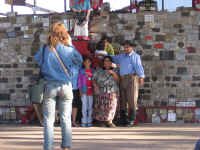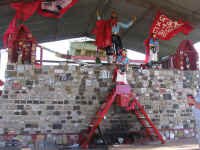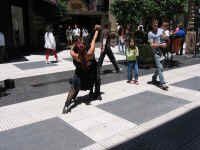|
Dec. 19-24, 2005 - Buenos Aires This morning we visited the shrine of "Gauchito" Antonio Gil outside of Mercedes in the state of Corrientes. As the story goes, in the 1850's, Gil made a name for himself by robbing from the rich and giving to the poor. When he was finally caught, he was sentenced to execution. Just before dying, Gil told the sergeant in command that the sergeant's son was dying and the child would be spared if the sergeant prayed for Gil's soul. When the boy recovered, the sergeant placed a cross at the site of Gil's death. Now the site is a shrine filled with tributes and exhortations of thanks from the many, many people who claim miracles from "Gauchito" Gil. Red flags symbolize adherence to the "cult" of Gil and they can be found along roadsides all across the country. Our experience was one of awe at the numbers of people who claim that Gil has helped them and the devotion of his followers. There were thousands of plaques attached to every flat surface surrounding the shrine and candles and offerings and ribbons adorned the ground. We were even able to buy a red ribbon requesting "Gauchito" Gil to protect our truck. It was quite an amazing sight. We then moved on to the Parque Nacional El Palmar. This park was created in 1966 to protect the native yatay-palm. The area looks very much the way it did in the 19th century, before the settlers moved in and started ranching and farming, with thousands of palms covering the area. The park is right on the Uruguay River (which marks the border between Argentina and Uruguay) and is a lovely area to look for mammals and birds. We took an early morning bike ride and enjoyed the coolness of the park before the day became too hot. Continuing on to the town of Colon, we discovered a delightful 19th century town with tree-lined streets and attractive buildings. Many people visit the town for its thermal springs and it is set up for tourism. This made our stay pleasant in that we were able to find a bank, access the internet and run some errands easily. We then headed to the municipal campground which was right on the river's edge. There was a very nice beach where tons of families were picnicking and playing in the water. We continued our southward trek toward the community of San Antonio de Areco. This 18th century town is Argentina's unofficial gaucho capital and it is host to its biggest gaucho festival every November, although we actually saw more gauchos as we drove through the countryside further north. The area's silversmiths are also the country's finest and we visited many shops selling the traditional garb of the gaucho and silver adornments. The town provided some interesting moments as we navigated through its tree-lined streets (we always have to be careful not to hit low hanging branches) but we finally made it to the pleasant municipal campground right on a river. We strolled along its banks and enjoyed the interesting flood control/swimming area with its waterfalls and bridges. Next was the town of Lujan with its magnificent basilica. Lujan gets four million visitors a year who come to see a statue of the Virgin Mary. Legend has it that in 1630, an oxcart carrying the terra cotta statue of the Virgin became stuck in mud and was unable to move until gauchos removed the 3 foot tall statue. Its devout owner declared that it was a sign that the Virgin should stay at the spot and built a chapel for her. She has since been "upgraded" and holds the place of honor in the Basilica Senora de Lujan which soars 106 meters high. It is a very imposing sight as you enter the town. Today we arrived in the city of Buenos Aires. As it was a Saturday, the drive into the city was actually quite pleasant. The signage and our map were very helpful and we were able to easily make our way to the Puerto Madero section of the city. We chose this area because it is known for its open spaces and would easily provide a spot to park the Fuso. The area is a landfill where the government dumped debris from massive public works projects during the 1970's & 80's. Over the past decade the scene has changed from one of abandonment to one of huge building projects. The open space won't last long, but for now it was the perfect spot for us. It is also close to the center of town and the subway. Our day started with a visit to the Plaza de Mayo where all of Argentina's political drama is played out. One end of the plaza is occupied by the Casa Rosada, the presidential palace with it's famous balcony. It is here that presidents (and president's wives, read Eva Peron) have carried out their fiery speeches to galvanize the people to their point of view. The plaza has been filled with supporters and jeerers since it was built in 1580 and has been the sight of both triumph and tragedy. Our informal walking tour took us past the Congreso Nacional, the Catedral Metropolitana, the Banco de la Nacion, all beautifully designed buildings built in the 1800 & 1900's. Another Buenos Aires institution we visited was the Cafe Tortoni which was built in 1858. This restaurant has been visited by celebrities and locals alike and looks much like it did when it was built. Its black-clad waiters lend an air of dignity and the place was full of tourists.
We then entered the subway system and made our way to the Recoleta section of the city where the rich go to "live and die". Recoleta is famed for its expensive home and shops, but especially for the huge and elaborate cemetery where it is essential that the final repose take place. It isn't easy to get in however. Only those with VIP status can be buried here. Eva Peron's tomb is here, but Juan Peron's is not.
|


